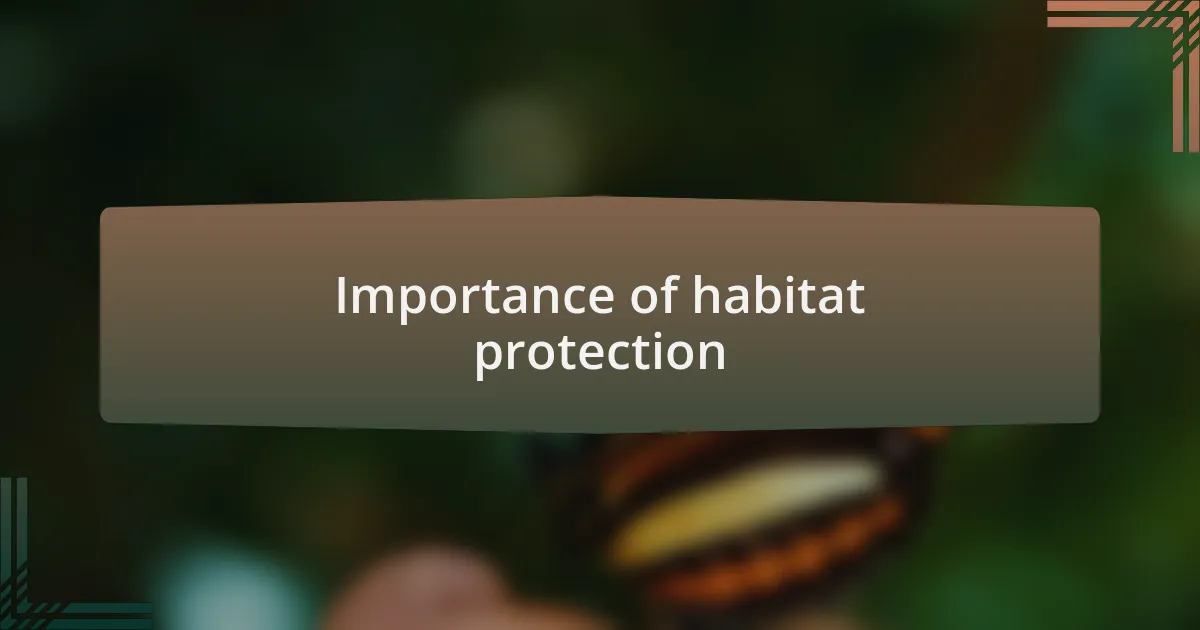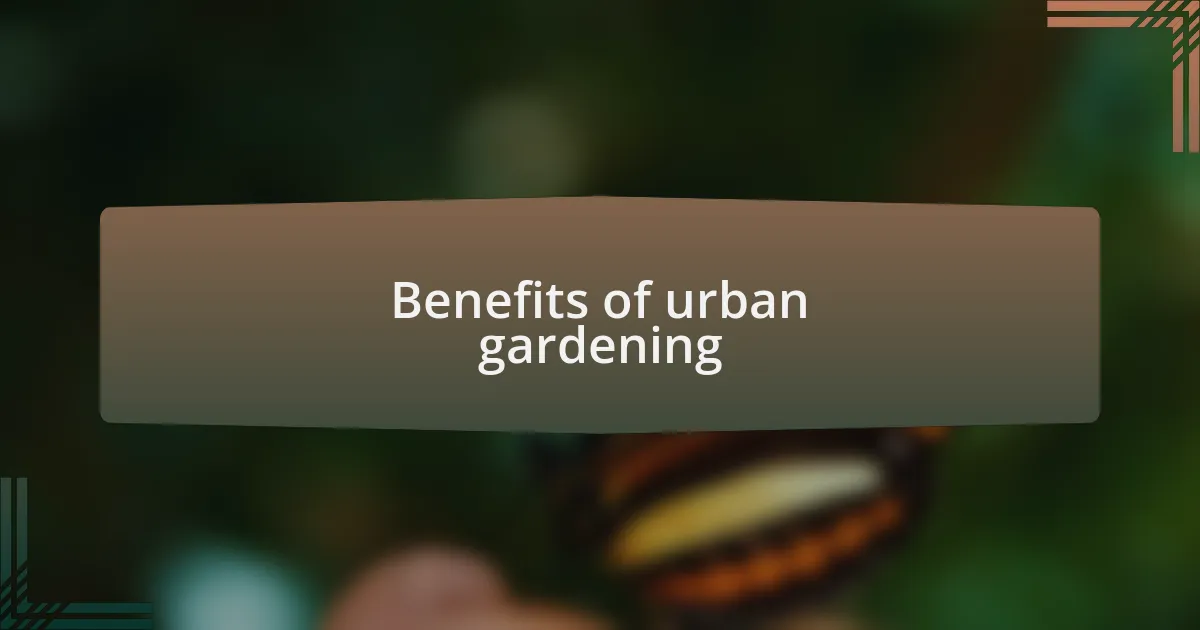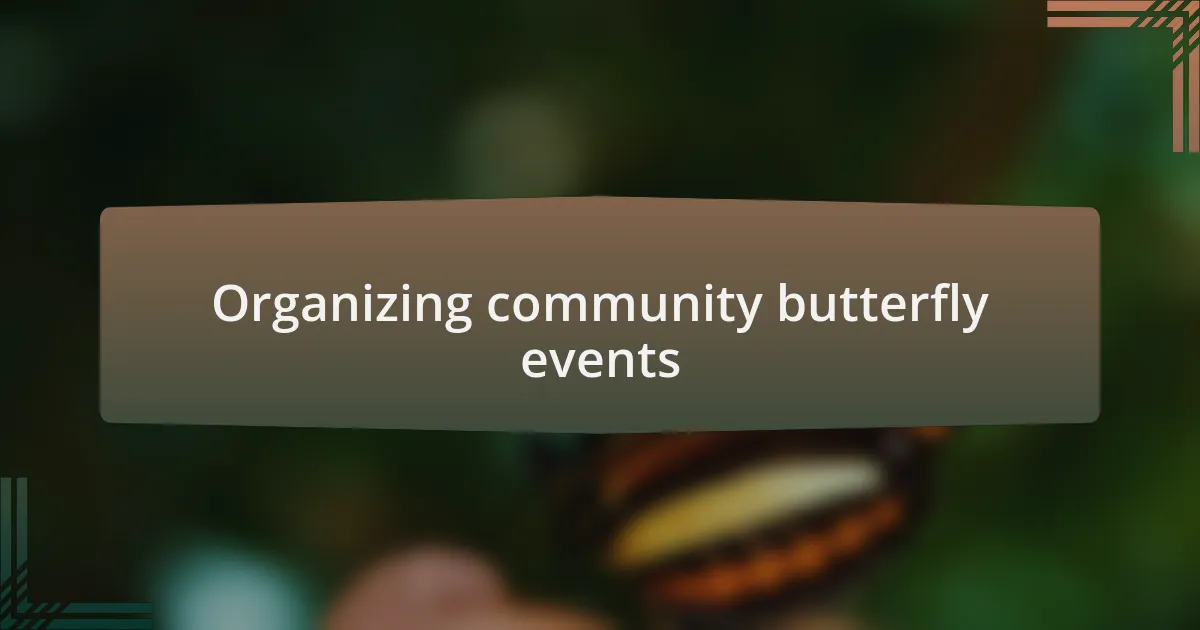Key takeaways:
- Butterfly conservation is essential for protecting ecosystems, as butterflies are indicators of environmental health.
- Engaging the community through activities like butterfly gardens, workshops, and events fosters collective responsibility for conservation.
- Urban gardening and habitat protection not only support butterflies but also promote sustainability and biodiversity.
- Sharing success stories inspires others to participate in conservation efforts, creating a ripple effect of positive action.

Butterfly conservation explained
Butterfly conservation is about protecting these beautiful insects and their habitats, which are often at risk due to habitat loss, pesticides, and climate change. I remember walking through a meadow filled with fluttering butterflies and thinking about how fragile their existence is. Each flutter is a reminder of what we stand to lose without dedicated conservation efforts.
Understanding the lifecycle of butterflies is crucial in conservation efforts. From caterpillar to chrysalis and finally to winged beauty, each stage is vulnerable. I often wonder how many children have marveled at the transformation, unaware that these wonders depend on our actions.
Engaging in butterfly conservation means creating environments that support their needs. Planting native flowers is a simple yet powerful act that can make a difference in your backyard. When I planted a butterfly garden, I felt an incredible joy seeing them thrive, and it made me realize that each of us has the power to inspire change.

Importance of habitat protection
Protecting habitats is essential not just for butterflies but for the entire ecosystem. I recall a day spent volunteering in a local park, where we cleared invasive species that threatened the native flora. The moment I saw a butterfly return to a flower we had nurtured, it struck me how interconnected our actions are; preserving their habitat means so much more than just saving a species.
Without intact habitats, butterflies struggle to find food and safe places to reproduce. I often think about the time I observed a whole brood of caterpillars virtually disappearing from a once-thriving patch due to habitat degradation. Isn’t it heartbreaking to consider that a single decision, like the use of certain chemicals in our gardens, can ripple out and impact entire populations?
Habitat protection is also about fostering biodiversity, which ultimately supports human populations as well. I remember the vibrant sounds and colors that filled the air during my childhood visits to preserved areas, and I often wonder if our own quality of life could diminish alongside disappearing species. It’s clear to me that the fate of butterflies is inextricably linked to our own, highlighting why we must prioritize habitat protection in our conservation efforts.

Benefits of urban gardening
Urban gardening offers a multitude of benefits that often go unnoticed. I once turned a neglected corner of my backyard into a blooming vegetable patch, and watching the transformation sparked joy not just for me but for everyone in the neighborhood. Have you ever wondered how much a small garden could uplift community spirits? The buzz of bees and colors of blooming flowers can create a sense of togetherness among neighbors, encouraging them to participate in shared environmental goals.
Moreover, urban gardens serve as essential habitats for local wildlife, including butterflies. I vividly remember one evening, sitting outside with a cup of tea, observing butterflies flitting from flower to flower in my little garden. It really hit me then: my effort could mean a safe haven for these delicate creatures. Isn’t it remarkable how a few planted flowers can invite these beautiful visitors into our lives and contribute to a healthier ecosystem?
Finally, let’s not forget that urban gardening promotes sustainable practices. When I began composting kitchen scraps and using rainwater for my garden, I could feel I was minimizing my environmental footprint. Have you tried something similar? The process not only nourished my plants but also inspired a few neighbors to think about their own waste practices. It’s these small, interconnected actions that add up and create a ripple effect, leading to more conscious, environmentally-friendly communities.

Engaging neighbors in conservation
Engaging neighbors in conservation starts with small conversations. I recall chatting with a neighbor during a weekend BBQ about the plight of local butterflies. That simple exchange led to us planning a neighborhood cleanup day, where we could not only tidy our shared spaces but also discuss how to create more butterfly-friendly habitats. Who knew our casual dinner could spark such meaningful action?
Creating community events is another powerful way to involve those around you. I once organized a “Butterfly Garden Workshop” in the park, where families could plant native flowers together. Watching kids’ excitement as they dug their little hands into dirt made me realize how infectious enthusiasm can be. It wasn’t just about gardening; it was about connecting with nature and each other—an experience that united our community in a shared cause.
And let’s talk about visibility. When my garden flourished with colorful blooms, neighbors began dropping by to admire it. This casual interest often turned into discussions about their own gardening efforts and the impacts on local wildlife. Have you had moments like that, where your passion sparks curiosity in others? It’s beautiful to witness how these interactions foster a sense of collective responsibility for our environment, encouraging more people to join the cause.

Organizing community butterfly events
One of the most rewarding events I organized was a “Butterfly Count Day.” Inspired by a local group’s initiative, I invited neighbors to join me in surveying our yards for different butterfly species. The evidence we gathered wasn’t just data; it became a rich conversation starter. As we tallied our findings over lemonade, I saw eyes light up with newfound wonder. Isn’t it amazing how nature can bring us together while contributing to science?
Another memorable experience was hosting a “Butterfly Art Day” where children painted stones and created signage for butterfly gardens. I still remember the laughter as the kids transformed mundane pebbles into vibrant little artworks. Watching their pride as they placed these markers in their gardens, I realized how small activities can cultivate a sense of ownership and love for the environment. Do you think creativity plays a significant role in conservation?
I also found that community potlucks themed around butterfly-friendly recipes effectively engaged my neighbors. I set up a table featuring dishes made from local fruits and vegetables, emphasizing how supporting local biodiversity is beneficial not just for butterflies, but for our health too. The conversations that stemmed from sharing recipes were enlightening; many expressed their eagerness to create pollinator gardens at home. Have you ever seen food spark such productive dialogue? It’s a beautiful reminder that while we enjoy food, we can equally cultivate community and commitment to protecting our habitats.

Sharing success stories with neighbors
I remember sharing my experience of nurturing a butterfly garden with my neighbors during a casual evening chat. As I recounted the fluttering visitors that filled my space, I could see their curiosity spark. It was inspiring to see how my passion ignited interest in their own yards, leading them to consider adding plants that attract these lovely creatures. Hasn’t it been said that seeing is believing?
One evening, over a backyard bonfire, I shared the story of how our collective efforts led to a record increase in local butterfly species. The pride that bubbled in our community was palpable. Hearing their enthusiasm turn into commitments to create their own butterfly-friendly spaces made me realize how success stories can be contagious. What if those small victories could lead to a beautiful chain reaction in habitat protection?
Another time, I created a simple flyer highlighting our shared accomplishments and success in attracting local butterflies. As I distributed these to my neighbors, I could feel the energy shift; they wanted to be part of something bigger. These success stories not only celebrate what we’ve done but inspire us to continue the journey together. Has there ever been a moment where you felt inspired to join a cause just by hearing about someone else’s success?